Compact, High Mass EMT 928 II Turntable Plus EMT 909-HI Tonearm— Sleek Looks and A Big Sonic Blast
the 928 II proves there's more than one way to "skin a turntable"
When in 2018 Micha Huber's Switzerland-based HiFiction AG bought the storied brand EMT Tontechnik, taking control of EMT's cartridge business including development, production, repair, and international distribution and moving it to his Winterthur, Switzerland factory, he clearly had more in mind than just phono cartridges, though that's the core business he purchased.
A year later in order to have space for both the EMT production line and increased demand for Thales turntables and tonearms, HiFiction moved into more spacious headquarters—a former spinning mill built in 1833—in the village of Turbenthal, close to both Winterthur and the Zurich airport. I visited the attractive sun splashed factory a few times and watched the cartridges being built. I had my hand at "tuning" one. It's tricky!
HiFiction, Turbenthal, Switzerland (part of the factory)
Micha Huber (center), Michael and non other than Erhard Breuer designer of the now legendary Breuer tonearm (photo taken in 2005 at Munich High End Show)
Founded by Wilhelm Franz in Berlin in 1940, EMT began life manufacturing broadcast equipment. In 1956 Franz's brother Walter founded Gerätewerk Lahr, which began manufacturing EMT's products. By decade's end EMT had developed its famous "plate reverb". EMT's 927 and 930 broadcast turntables and other models are still coveted by vinyl enthusiasts, first fitted with Ortofon-supplied tonearms, and later replaced by the famous EMT 997 "banana" tonearm. The 930 turntable incorporated a built-in vacuum tube–based mono phono preamplifier, the 139.
EMT entered the cartridge business in 1959 and a year later introduced a stereo moving coil design. I'm going to fast forward through some of the history because while it's interesting it's not relevant to this review, other than to add that the EMT move to Switzerland occurred over a four year period starting in 2014 when the original EMT crew, some having worked there for forty years, retired. During this transition new workers were taught how to build the cartridges.
The EMT 128 phono preamp ($11,995), which I reviewed for Stereophile began as a 1985 project to replace the phono preamp built into the EMT broadcast turntables but it was never completed. Once the EMT deal had been completed Huber contacted the retired project manager and convinced him to complete the electronics design, which features Raytheon 5784WB subminiature, dual-pentode, wire-terminated tubes originally developed for U.S. missile technology. Huber's team developed the rest.
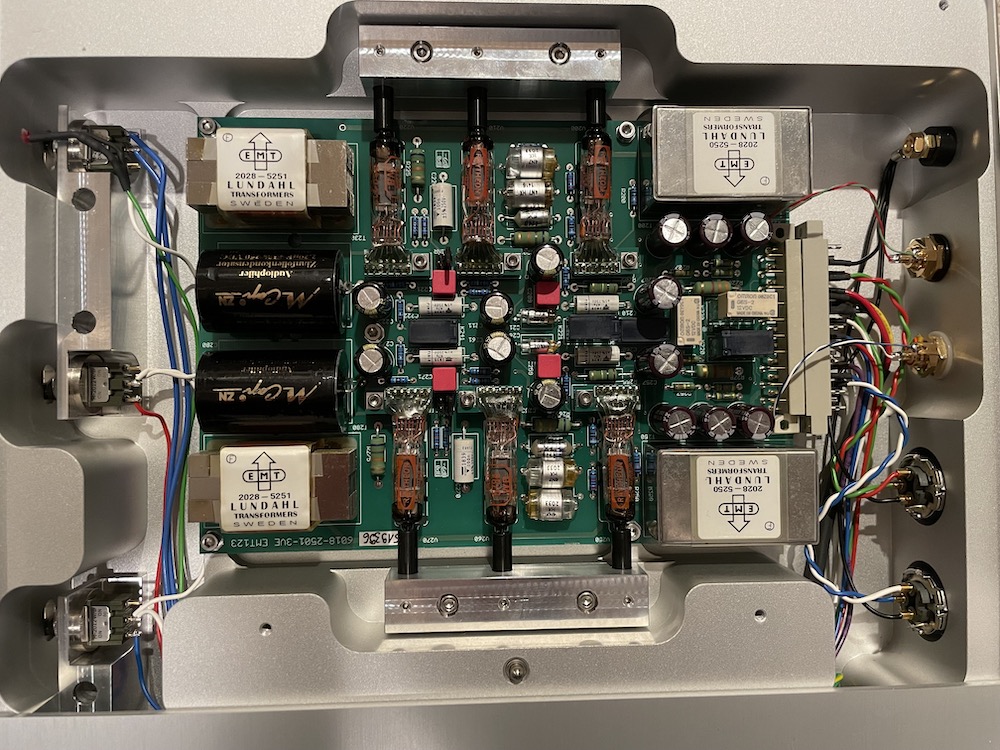 With the cartridge line complete and upgraded to higher standards and the phono preamp finished, Huber's next goal was to produce a new EMT turntable (though it's possible the two projects began simultaneously). The belt drive 928 takes its design cues from the sleek, machined from a single aluminum billet 128, not from the older "industrial strength" idler wheel drive EMTs, though in the 1970's EMT introduced a compact 928 belt drive turntable (its only belt design) in conjunction with Thorens, fitted with the 929 tonearm.
With the cartridge line complete and upgraded to higher standards and the phono preamp finished, Huber's next goal was to produce a new EMT turntable (though it's possible the two projects began simultaneously). The belt drive 928 takes its design cues from the sleek, machined from a single aluminum billet 128, not from the older "industrial strength" idler wheel drive EMTs, though in the 1970's EMT introduced a compact 928 belt drive turntable (its only belt design) in conjunction with Thorens, fitted with the 929 tonearm.
So, if you're wondering why this new turntable is called the 928 II and where's the first 928, it's this one:
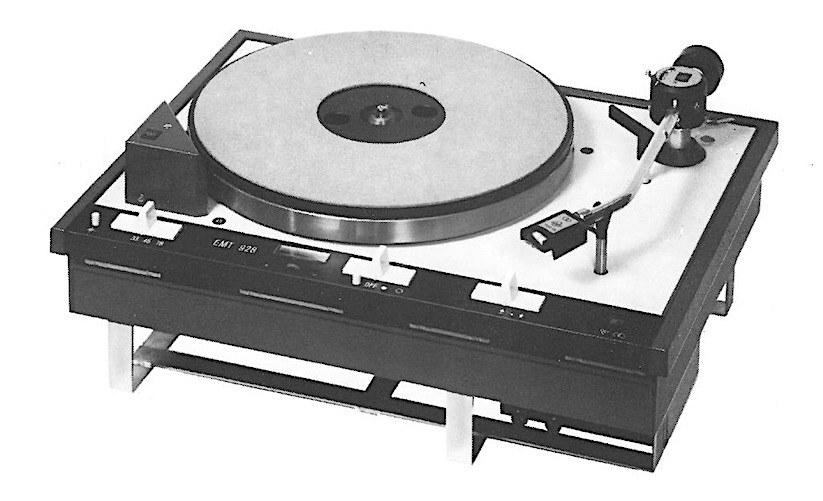 Below is a more typical radio station/studio grade EMT idler drive turntable, in this case a 948 I saw in Berlin a few years ago.
Below is a more typical radio station/studio grade EMT idler drive turntable, in this case a 948 I saw in Berlin a few years ago.
EMT 948 Turntable
The EMT 928 II Turntable
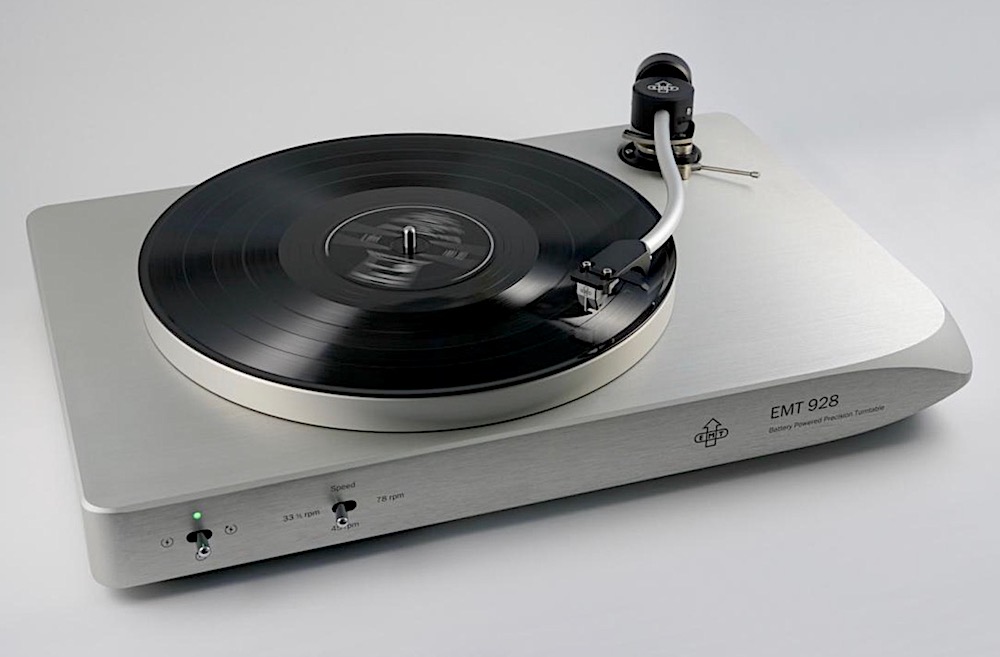 Though EMT is the brand, the 928 has more in common with the very similar Thales battery powered belt drive turntables like the one below, the TTT Compact II, though there are significant differences and the TTT Compact II, for instance, is specifically designed and "tuned" to be used with Thales' Simplicity II pivoted tangential tracking tonearm:
Though EMT is the brand, the 928 has more in common with the very similar Thales battery powered belt drive turntables like the one below, the TTT Compact II, though there are significant differences and the TTT Compact II, for instance, is specifically designed and "tuned" to be used with Thales' Simplicity II pivoted tangential tracking tonearm:
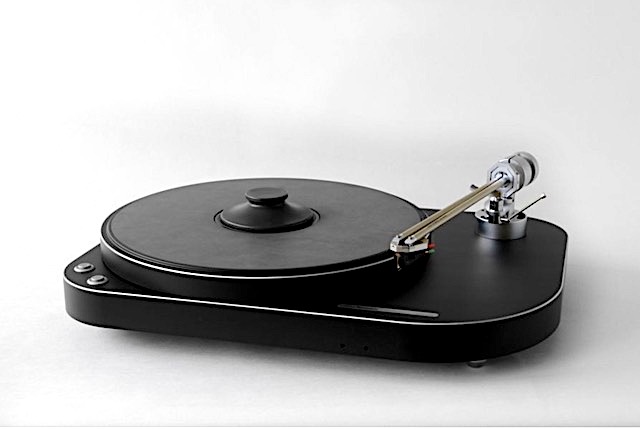 My dear late friend Art Dudley reviewed the TTT Slim II ($6750) with the Simplicity II arm ($9450), which packaged together in 2019 cost $14,180. The 928 II can be purchased without arm, or as a package (as reviewed here) with the 909 HI arm. The 'table alone costs $9,995. The arm alone costs $5995. The 'table/arm package costs $14,995, which saves you $1000.
My dear late friend Art Dudley reviewed the TTT Slim II ($6750) with the Simplicity II arm ($9450), which packaged together in 2019 cost $14,180. The 928 II can be purchased without arm, or as a package (as reviewed here) with the 909 HI arm. The 'table alone costs $9,995. The arm alone costs $5995. The 'table/arm package costs $14,995, which saves you $1000.
Basing the 928 on the elegantly designed and engineered Thales line makes complete sense. What appears simple to the eye is actually quite complex and despite its sleek look the assemblage weighs fifty pounds (the Thales 'table pictured above weighs roughly half as much)! Much of the stepped platter is hidden within a circular recess in which is a stepped sub-platter upon which it rides (I'm using the instructions' illustration rather than removing the top to take a picture).
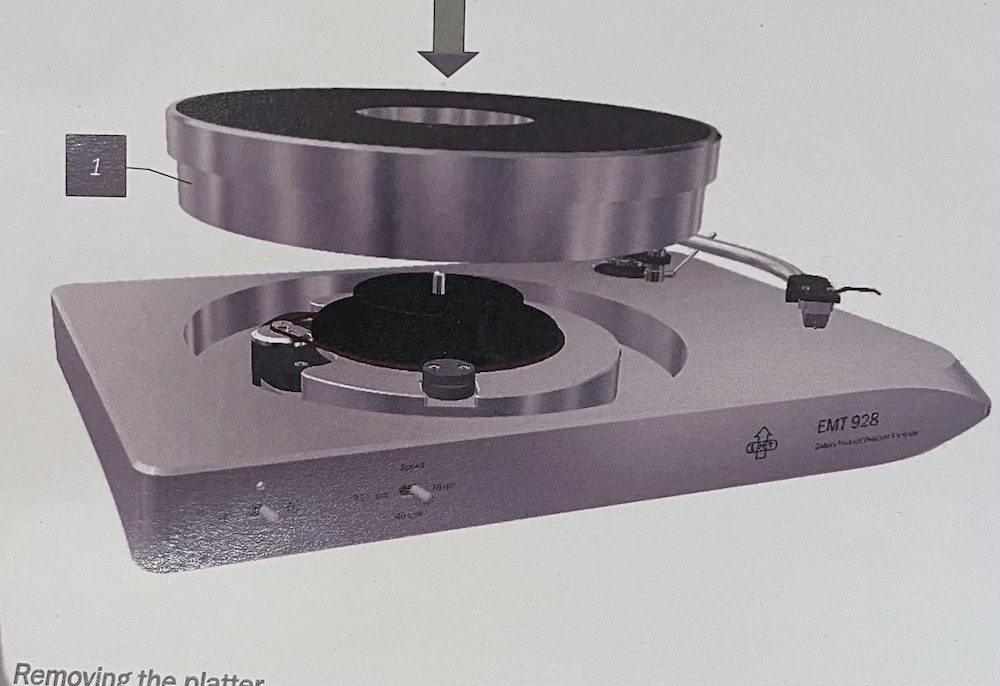 The top of the sub-platter sits level with the platter surface as you can see in this picture. The main platter features a high density mat inlay (precisely what it is, is not specified), the texture of which the lighting exaggerates.
The top of the sub-platter sits level with the platter surface as you can see in this picture. The main platter features a high density mat inlay (precisely what it is, is not specified), the texture of which the lighting exaggerates.
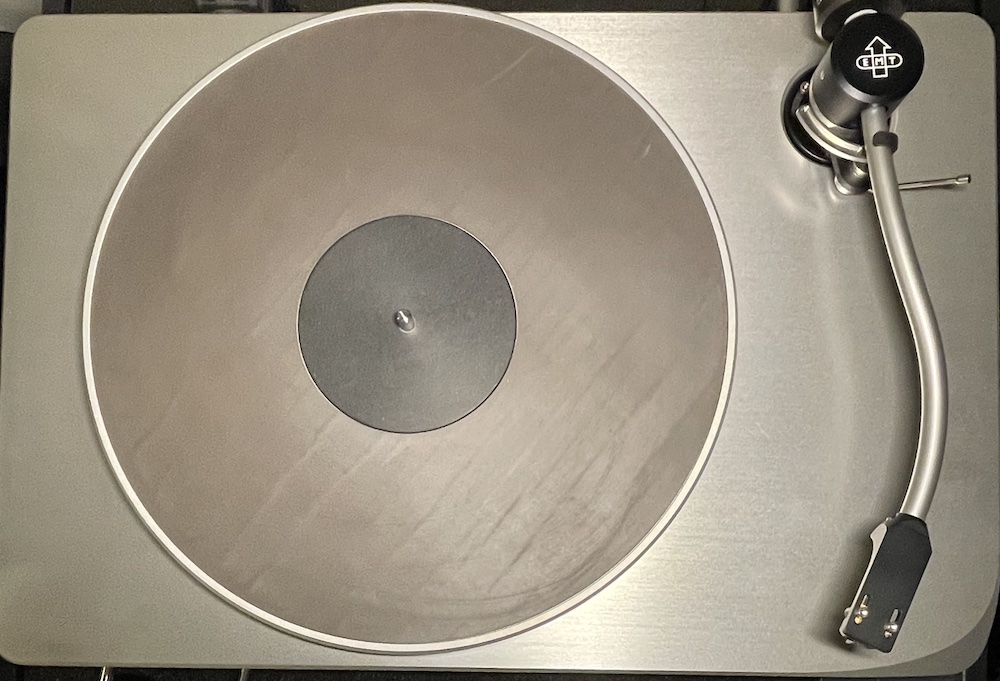 Here's the under the platter fixings:
Here's the under the platter fixings:
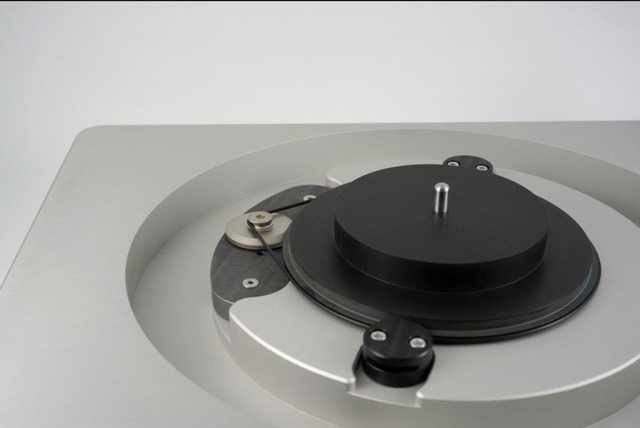 As you can see, the DC motor (20 watts) fitted with a metal pulley and enclosed in its own sub-enclosure positioned very close to the sub-platter to keep as short as possible the round cross-section belt. The assemblage is partly isolated from the chassis in its own sub-suspension (something I didn't notice until I'd removed the platter to pack it up for return). The belt rides within a groove machined into the sub-platter's lower platform. Two polymer shipping locks secure the sub-platter in place and elevate it to keep the spindle bottom from contacting the thrust pad.
As you can see, the DC motor (20 watts) fitted with a metal pulley and enclosed in its own sub-enclosure positioned very close to the sub-platter to keep as short as possible the round cross-section belt. The assemblage is partly isolated from the chassis in its own sub-suspension (something I didn't notice until I'd removed the platter to pack it up for return). The belt rides within a groove machined into the sub-platter's lower platform. Two polymer shipping locks secure the sub-platter in place and elevate it to keep the spindle bottom from contacting the thrust pad.
Removing the bolts, rotating the locks 180 degrees and bolting them back down frees and lowers the sub-platter and prevents buyers from losing the shipping locks. The designer knows audiophiles (and reviewers) well! As is so often the case, what appears to be "simplicity itself" is actually a complex production requiring precise machining to successfully execute.
The bearing system isn't specified but if it's similar to the Thales's, it would include a permanently lubricated sintered bronze bushing and a hardened tool steel bearing shaft. The "high precision control loop circuit", battery and charger system are all built into the plinth.
Set Up And Use
You can order the 928 with or without the EMT 909 HI arm. Without, and EMT can supply an arm board cut for your arm choice. The review sample came with the 909 HI pre-installed. HiFiction's instruction manuals are exceptionally well written and illustrated and the packaging is equally high quality, so unboxing is a pleasant task. The 'table sits on four adjustable feet at least one of which EMT says should be fully screwed in. Of course it's best to start with a level surface.
It takes but a few minutes to have the packing bolts rotated and bolted back down and the platter lowered onto the chassis. That's really it for "set-up" other than connecting the A.C. cord to the IEC jack and plugging it in. There are a pair of easily accessible RCA jacks, a ground pin receptacle and access to a pair of small speed adjustment pots on the back panel and that's it.
There's no dust cover but really why would you need one (other than to protect the goods from cats, children and overzealous cleaning people)? Put a spare, discarded record on the platter and it's protected from dust.
A pair of three position toggle switches on the front of the chassis control all. The right hand switch selects 33 1/3, 45, or 78. The left hand three position switch sets charging mode/platter stopped, platter run "pure listening mode" (charger disconnected for best performance) or platter run "charging mode". The LED communicates six operating modes, three green and three red that alert you to all operational and charging functions. The turntable ran in pure battery mode the entire time I had it and that includes almost all day listening sessions.
Shaknspin results were very good. Note the out of the box speed accuracy.
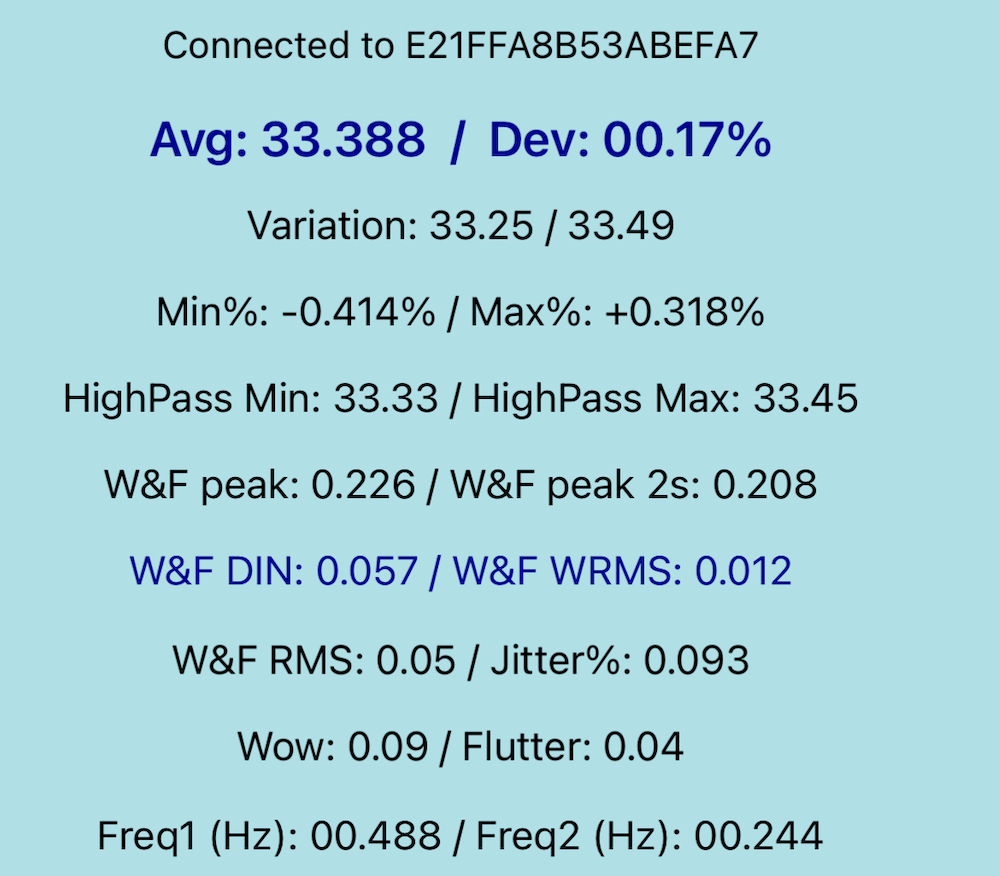
The EMT 909 HI Tonearm
The new 928 II's arm is clearly derived from the older, classic EMT 929 and 997 'banana' arms, the production of which was discontinued in 2018. And why not? It's a well-respected design that has a definite fan base.
HiFiction claims the new arms "...integrate the most modern bearing manufacturing technologies" into the traditional arm design. There are two variants available in either, 9" or 12" lengths, one with fixed head shells (the HI version as supplied here) and the PROFESSIONAL version with EMT connection for the Tondose cartridge line (the link happens to be to a Tennessee-based dealer that has an exceptionally useful and well-organized website).
Like the turntable's, the arm's instruction manual is exemplary. Pivot to spindle distance is 230mm, effective length is 246.75, effective mass is 10.3 grams , overhang is of course 16.75 (effective length minus pivot to spindle distance).
Two versions are available: one in which you solder tinned wires to RCA jacks (as delivered here) and one termination in a DIN jack. The arm allows for all adjustments including VTA/SRA and azimuth—none "on the fly". Anti-skating is via a contactless magnetic system, via a numbered dial around the bearing housing periphery. An integrated tracking force scale makes easy setting VTF—as does the spring loaded pin equipped counterweight and spiral counterweight stub, but an external digital gauge is always recommended for greater precision.
Azimuth adjustment is at the head shell. On a "J"shaped arm like this, where the offset angle is set on the arm tube and not at the head shell, and the head shell rotates tangential to the groove, setting azimuth does not negatively affect other set-up parameters. Setting up the 909 HI was a pleasure. One caution: while the arm rest offers a secure grasp via a flexible material, watch what you are doing when placing the arm into the rest. If you aren't careful it can spring forward and launch the arm across the record!
The JSD Pure Black MC Cartridge
Mo-Fi Distribution supplied a $4495 EMT JSD Pure Black MC cartridge and that's the only cartridge used for the review. if you buy the turntable, you're likely to want an EMT cartridge, though the arm can accommodate most low to medium compliance cartridges. The JSD Pure Black, like most if not all EMT cartridges does not include a stylus guard so you must be extremely careful handing and installing it. EMT says the stylus is good for "at least" 1500 hours and recommends a return to the factory inspection and "tune-up" every four years.
The cartridge body features a resonance reducing layer and features a micro-ridge stylus and sapphire cantilever as part of an "old school" tried and true motor construction, the details of which I won't go into here. Recommended tracking force is 2.4g ±0.1g. Output is a generous 1.05mV@5cm/s, which explains the relatively high 24Ω internal impedance. Compliance is 12µm/mN. See spec below for the complete list.
Only a slight azimuth adjustment was required to maximize and equalize L-R and R-L separation, which was approximately 30dB. The cartridge tracked the Ortofon test record cleanly to 70µm peak, which in my experience is expected performance for a high quality MC cartridge.
Sounds Great Too!
What I was getting at in the sub-head "more than one way to skin a turntable" is this: consider this turntable's high mass and lack of any kind of suspension versus the Rega featherweight mass is best approach. Tap the platform on which the 928 II sat (admittedly an excellent HRS base) and but the slightest fast evaporating sound came from the speakers and not at a low "thump" frequency range.Tapping the plinth during play produced a different, somewhat higher but equally "well-behaved" quickly evaporating sound: no, hollow, long-lasting low frequency "bump". That doesn't tell you everything about how a turntable will sound (or not sound) but it tells you something important, especially about the 'table's low frequency performance, which as you can figure out was fast, clean, well-extended and just plain solid.
Shortly I'll be reviewing a new Sam Records release The Heath Brothers Paris 1976 (Sam SRLP29) sourced from a great-sounding French radio show "Jazz Vivant" tape. It required some high resolution digital tape restoration with files cut by Kevin Gray, but you'll only hear smooth and sweet, and vivid three-dimensionality plus lots of air in a room filled with rabid fans—at least that what I heard through this EMT combo into a variety or phono preamps, but best for this cartridge was using a TONA T20/40 moving coil step-up transformer. EMT cartridges like step up transformers and with its high internal impedance the JSD Pure Black is not a prime candidate for a transimpedance type phono preamp. I ran it into the MM input of the van den hul The Grail SX phono preamp, which like the lower cost version I reviewed a few years ago, as neutral a sonic carrier as you're likely to hear. Non-fans call it "without soul" but whatever! This combination just clicked.
Jimmy Heath plays flute on the breezy "Watergate Blues" (it's from the mid '70s don't forget!) and that flute floats boldly in three-dimensional space between and at the front of the soundstage in "reach out and grab it" 3D style.
At one show or another last year or maybe two years ago, our Dave McNair played a lacquer for me he'd cut for an upcoming reissue of Los Lobos's epic Kiko (Slash/Warner Records R1-725671). He'd been sent a high resolution 2 inch 30 IPS master tape transfer (for the actual review I'll get precise details) and he did all of the EQ work for his cut. It was amazing. Best I've ever heard Kiko sound by far—especially because Dave convinced Rhino to do it on 3 sides.
Now I've got the final result, which had to be cut by Dave's friend Nick Townsend from Dave's files, because his lathe pooped out (it's now on the mend) and Record Industry pressed and did a great job.
This record told me that the EMT 928 II can rock! Bottom end was slamming' good, drums and cymbals were delivered cleanly and I hate to use the word crisp, which I reserve for potato chips but you get the picture. This was a seriously great sonic performance. The kick drum on the opener "Dream Is Blue, was punchy and deep as you'll hear a kick drum on record, which is plenty deep!
Switching "cold turkey" from Los Lobos to the Gundula Janowitz, Von Karajan and the BPO Strauss record Mark Ward recently raved about, part of the DGG "Original Source" series (I found I had an original pressing in my archives), produced equally "get out of the way and let the music through" performance.The stage was enticingly 3D and transparent, and the first big orchestral explosion on "Death and Transfiguration" startled, emerging by surprise from a black background.
On side two Janowitz's voice was as Ward described, appearing—presenting itself with "you are there in the hall" verisimilitude:
"Well, I wasn’t disappointed - and neither will you be. Just as on that recording, you will hear Janowitz’s voice seemingly unmediated by technology. And it is a thing of wonder."
If this combination was every so slightly on the "highly present" side of the sonic spectrum (probably the Grail SX producing that), it never got bright or shouty, but it was always engaging, transparent and when the recording was, three-dimensionally vivid and completely free of mechanical artifice. A sonic festival for every musical genre.
Conclusion
What's not to love about this turntable/arm combo, especially if you want something that's easy to use and set up, is compact, great to look at, built like a proverbial tank, will stay set up and with all the "guts" below ground, has absolutely nothing to fiddle with. Plus of course it sounds great.
Look, $15K isn't exactly chump change, but it's also not out of reach for many of us. There's competition out there worthy of consideration— I could name more than a few (as well as a series of arms that would mate well with it), but that's for a different kind of piece—and really, there's something about the 928 II's sleek, compact, low profile look that sets it apart from the rest. I'll be sorry to see this one go. Well worth considering if this is in the price range in which you're looking. The EMT 928 II is truly an explosive-sounding compact, disc player.
Specifications
Turntable
Platter speed: | 33⅓ / 45 / 78rpm |
Wow and flutter: | ±0,07% (IEC 386) |
Rumble: | -85dB (IEC 98) |
Speed-up time: | 10 / 12 / 20s |
Battery service life: | 40 / 38 / 30h |
Dimension: | 480x340x100mm |
Weight: | 23kg |
Input voltage: | 100-240VAC, 50-60Hz |
Output terminal: | RCA, with separated tonearm ground |
Mounting distance arm: | 215-245mm, prepared for EMT 9-inch tonearm |
Tonearm:
Effective mass: | 10.2g |
Cartridge weight: | 10…25g |
Effective length: | 246.75mm |
Offset angle: | 22.25° |
Overhang: | 16.75mm |
Null points: | 120.9 / 66.04mm |
Output (Standard): | wire outlet 20cm |
Output (Option DIN): | 5-pin DIN outlet |
Cartridge:
Diamond: | MR HP |
Cantilever: | Sapphire |
Transducer: | MC Stereo |
Coil Standard: | Pure Copper |
Coil Option AG: | Pure Silver |
Magnet: | AlNiCo, gold-plated |
Body: | Aluminium, black anodized |
Connection: | 1/2" – 4pin |
Vertical Tracking Angle: | 23° |
Weight: | 10g |
Tracking force: | 2,4g |
Output voltage: | 1.05mV @ 5cm/s |
Compliance: | 12µm/mN |
Frequency response: | 20 - 30‘000Hz |
Impedance: | 2x 24Ω |
Recommended load: | 200 - 300Ω |
Manufacturer Information
EMT Tontechnik
Tösstalstrasse 14
8488 Turbenthal, Switzerland
Imported to USA by:
1811 W. Bryn Mawr Ave,
Chicago, IL 60660
U.S.A.


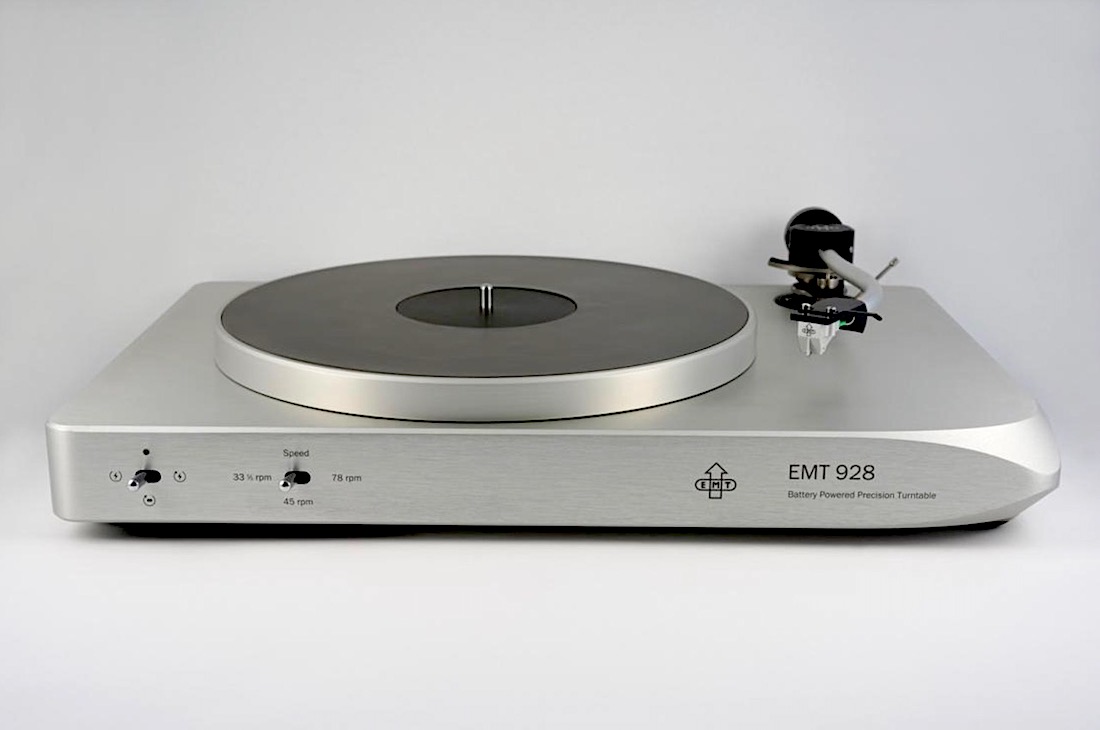







































.png)








